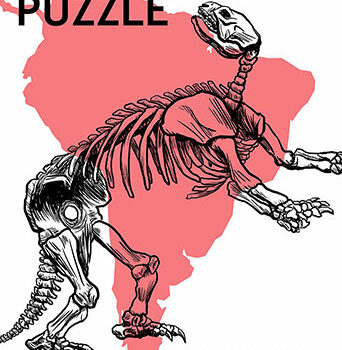Grade Level(s):
- 6-8
- 9-12
- General
- Student
Source:
- UC Museum of Paleontology
Resource type:
- Comic
Time: 20 minutes
Overview
In this comic, you'll follow the investigation of scientists Maria and Miguel as they solve a paleontological mystery. About 11,000 years ago, more than 80% of the large animal species in South America went extinct. Why did it happen? (Available in English, Spanish, and Portuguese)

- [History of life: Grades 9-12] Present-day species evolved from earlier species; the relatedness of organisms is the result of common ancestry. (LS4.A)
- [History of life: Grades 6-8] Life forms of the past were in some ways very different from living forms of today, but in other ways very similar. (LS4.A)
- [History of life: Grades 6-8] Present-day life forms are descended from past life forms; all life is related. (LS4.A)
- [History of life: Grades 6-8] Mass extinctions occur.
- [History of life: Grades 6-8] Extinction can result from environmental change.
- [History of life: Grades 9-12] Life forms of the past were in some ways very different from living forms of today, but in other ways very similar. (LS4.A)
- [History of life: Grades 9-12] Mass extinctions occur.
- [History of life: Grades 9-12] Extinction can result from environmental change.
- [Evidence of evolution: Grades 6-8] Fossils provide evidence of past life. (LS4.A)
- [Evidence of evolution: Grades 6-8] There are similarities and differences among fossils and living organisms. (LS4.A)
- [Evidence of evolution: Grades 9-12] The fossil record provides evidence for evolution.
- [Evidence of evolution: Grades 9-12] The fossil record documents the biodiversity of the past.
- [Evidence of evolution: Grades 9-12] The fossil record documents patterns of extinction and the appearance of new forms.
- [Evidence of evolution: Grades 9-12] Radiometric dating can often be used to determine the age of fossils.
- [Evidence of evolution: Grades 9-12] There are similarities and differences among fossils and living organisms.
- [Mechanisms of evolution: Grades 6-8] Organisms with similar requirements may compete with one another for limited resources.
- [Nature of science: Grades 6-8] Scientific knowledge is open to question and revision as we come up with new ideas and discover new evidence. (P6, NOS3)
- [Nature of science: Grades 6-8] A hallmark of science is exposing ideas to testing. (P3, P4, P6, P7)
- [Nature of science: Grades 6-8] Scientists test their ideas using multiple lines of evidence.
- [Nature of science: Grades 6-8] Scientists use multiple research methods (experiments, observations, comparisons, and modeling) to collect evidence. (P2, P3, P4, NOS1)
- [Nature of science: Grades 6-8] Scientists can test ideas about events and processes long past, very distant, and not directly observable.
- [Nature of science: Grades 6-8] Science is a human endeavor. (NOS7)
- [Nature of science: Grades 9-12] Scientific knowledge is open to question and revision as we come up with new ideas and discover new evidence. (P4, P6, NOS3)
- [Nature of science: Grades 9-12] A hallmark of science is exposing ideas to testing. (P3, P4, P6, P7)
- [Nature of science: Grades 9-12] Scientists test their ideas using multiple lines of evidence. (P6, NOS2)
- [Nature of science: Grades 9-12] Scientists use multiple research methods (experiments, observational research, comparative research, and modeling) to collect data. (P2, P3, P4, NOS1)
- [Nature of science: Grades 9-12] Scientists can test ideas about events and processes long past, very distant, and not directly observable.
- [Nature of science: Grades 9-12] Science is a human endeavor. (NOS7)
- [Studying evolution: Grades 6-8] Our knowledge of the evolution of living things is always being refined as we gather more evidence.
- [Studying evolution: Grades 6-8] Scientists use multiple lines of evidence to study life over time.
- [Studying evolution: Grades 6-8] Scientists use fossils to learn about past life. (LS4.A, ESS1.C)
- [Studying evolution: Grades 6-8] Scientists use geological evidence to establish the age of fossils.
- [Studying evolution: Grades 9-12] Our knowledge of the evolution of living things is always being refined as we gather more evidence.
- [Studying evolution: Grades 9-12] Our understanding of life through time is based upon multiple lines of evidence.
- [Studying evolution: Grades 9-12] Scientists use fossils (including sequences of fossils showing gradual change over time) to learn about past life.
- [Studying evolution: Grades 9-12] Scientists use physical, chemical, and geological evidence to establish the age of fossils.
- [Studying evolution: Grades 9-12] Scientists use the geographic distribution of fossils and living things to learn about the history of life.
- [Studying evolution: Grades 9-12] As with other scientific disciplines, evolutionary biology has applications that factor into everyday life.
- Disciplinary Core Idea LS4.A: Evidence of Common Ancestry and Diversity
- Disciplinary Core Idea ESS1.C: The History of Planet Earth
- NOS Matrix understanding category 1. Scientific investigations use a variety of methods.
- NOS Matrix understanding category 3. Scientific knowledge is open to revision in light of new evidence.
- NOS Matrix understanding category 7. Science is a human endeavor.
- Science and Engineering Practice 2. Developing and using models
- Science and Engineering Practice 4. Analyzing and interpreting data
- Science and Engineering Practice 6. Constructing explanations and designing solutions
- Science and Engineering Practice 7. Engaging in argument from evidence
This comic includes a glossary and comprehension questions for classroom discussion or an independent assignment.
